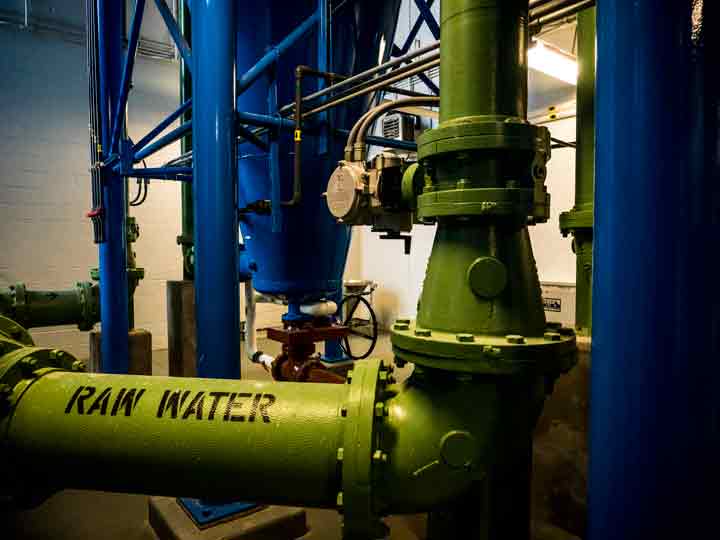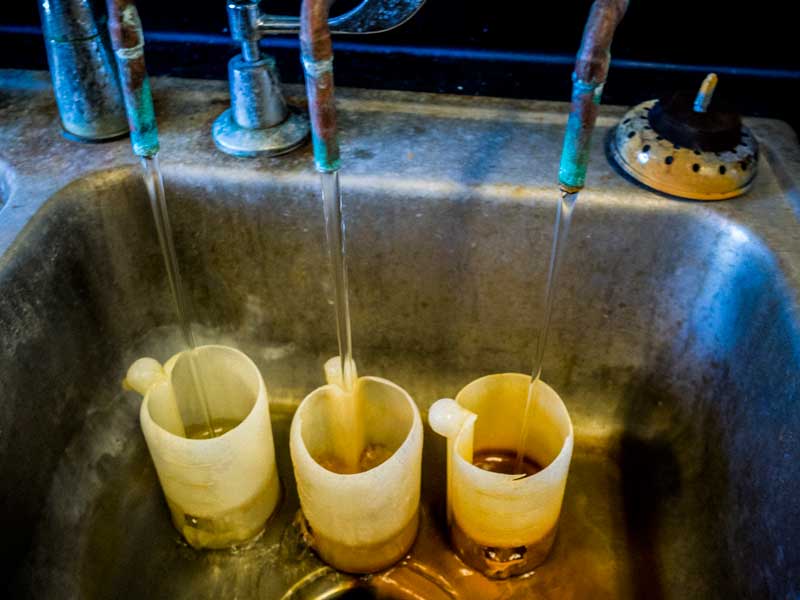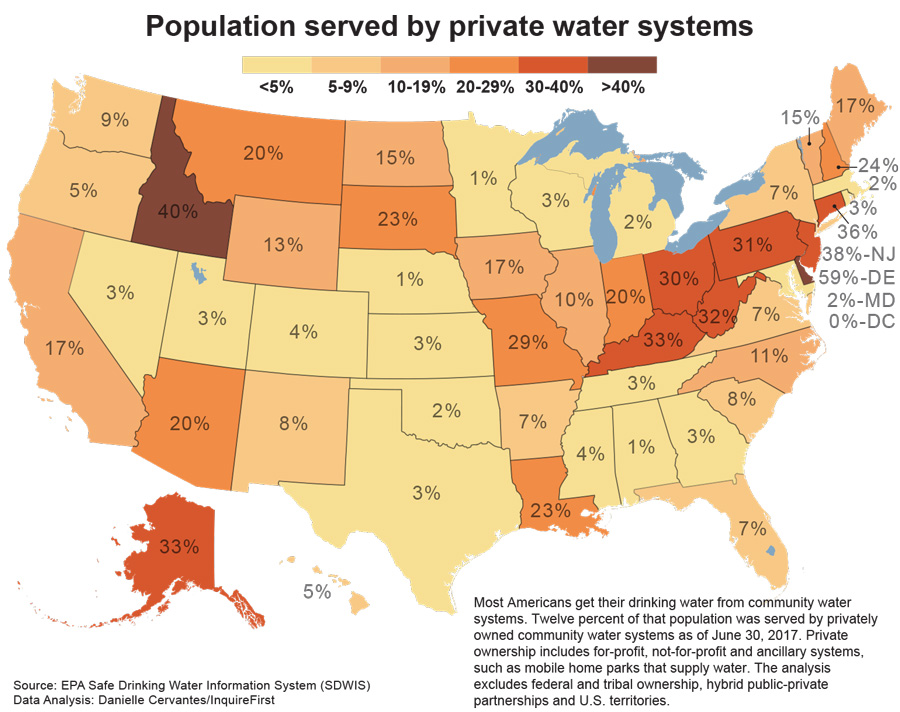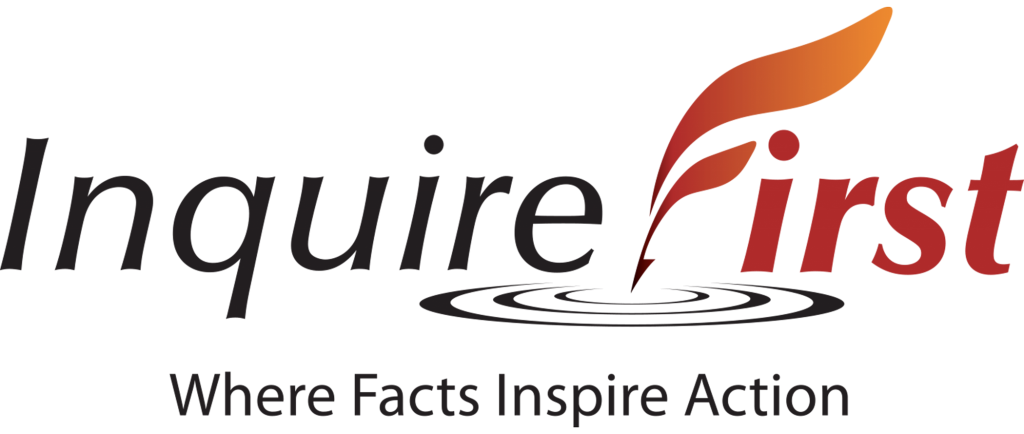


In Lake Station, Indiana, a divided city council voted in June to sell the aging municipal water system to American Water, the nation’s largest private water utility and the city’s only bidder. (Photos left to right) In a lab at the Lake Station water filtration plant, treated water is in the front flask and raw well water is in the background. Mayor Christopher Anderson reviews the city’s budget figures. The water filtration plant and five new wells went on line in 2015 and added more than $11 million to the city’s debt. Photos by John Nelson/InquireFirst
Towns Sell Their Public Water Systems – and Often Regret it
Will the United States continue to be a country where people can turn on the tap and assume the water that comes out is safe and affordable? In this, the first major report in InquireFirst’s long-term drinking water project, we begin answering that question by exploring the growing pressure on cities and towns to privatize their municipal drinking water systems.
A version of this story was published in The Washington Post
By Elizabeth Douglass
InquireFirst
LAKE STATION, Ind.—The 12,000 residents of Lake Station, Ind., a hard-luck town 29 miles from Chicago, are weighing a decision faced by other small and mid-sized cities with shrinking populations and chronic budget deficits: Should they sell their municipal water system to a for-profit corporation?
Lake Station desperately needs the cash. Once a solid middle-class city, it has suffered from a combination of job cutbacks and closures at nearby steel mills, statewide caps on property taxes, and debt from a pricey new City Hall. In less than a decade, the city’s operating budget has been nearly halved, to just $3.2 million. The aging water system, meanwhile, needs at least $4 million in repairs and upgrades.
The sale would erase more than $11 million in utility debt and leave the city with a $9 million windfall. But the deal doesn’t fund any of the water system’s overdue repairs, costs that will be passed along in higher rates.
“You’re in bad shape financially to where you’re talking about laying off police, so you’re going to have to do something,” Mayor Christopher Anderson said last November as he wrestled with the idea of privatizing his town’s most essential public service. “It’s been a stressful year just talking about it and gathering information. The biggest issue with privatizing is we’re losing control of the operations. The question is, is that a good thing or a bad thing considering the circumstances?”
Neglected water infrastructure is a national plague. By one estimate, U.S. water systems need to invest $1 trillion over the next 20 years. Meanwhile, federal funding for water infrastructure has fallen 74 percent in real dollars since 1977 and low-interest government loans haven’t filled the gap.
President Trump campaigned on a promise to rebuild the nation’s infrastructure, but his budget would actually reduce federal aid for water projects. It eliminates a $498 million loan program that helps rural communities fund water projects. And it adds only $4 million, or less than half a percent, to the State Revolving Funds, considered one of the government’s most essential and successful funding programs for local water projects. That means the revolving fund for drinking water, which got $863 million last year, would have its lowest budget in real dollars since it began in 1997, according to the Congressional Research Service.

The need to fix the water infrastructure problem is urgent for many of the nation’s 50,000 community water utilities. Broken or leaking pipes can contaminate water, flood streets, disrupt businesses and require expensive emergency repairs. Outdated treatment plants have trouble filtering out potentially harmful chemicals. Old pipes can leach dangerous levels of lead into drinking water. Some communities have higher lead levels than Flint, Mich., where a confluence of bad decisions and coverups led to widespread lead poisoning.
The prospect of offloading these headaches to for-profit water companies—and fattening city budgets in the process—is especially enticing to elected officials who worry that rate hikes could cost them their jobs, an attitude known as NIMTOO, or Not In My Term Of Office. Once a system is sold, the private operators, not public officials, take the flak for higher rates.
Privatization will not magically relieve Americans of the financial burden of upgrading their water infrastructure. Water customers still foot the bill. And although there are no reliable data to compare the service or safety records of public and private utilities, studies show that in most cases the tab rises when for-profit companies are involved.
That’s in part because state regulatory agencies allow private operators to earn a profit on their investments—American Water’s Indiana subsidiary currently collects 6.6 percent on these costs—giving them a strong incentive to upgrade systems more quickly than government-owned facilities.
Elected officials and the public “should ask good questions and they should understand the tradeoffs,” before agreeing to sell municipal water systems, said Janice Beecher, who studies both public and private systems as director of Michigan State University’s Institute of Public Utilities. Selling a publicly owned water utility “shouldn’t be rushed,” she warned, “because it is essentially a permanent shift. Once it’s gone, it’s gone.”
Privately owned water systems serve 12 percent of Americans connected to community water systems. But the figure is much higher—30 to 59 percent—in nine states, including several with industry-friendly policies. The private company share in Indiana is 20 percent, but that figure is poised to increase thanks to pending sales and at least six new laws benefitting for-profit water companies.
In 2015, investor-owned companies bought 48 water and sewer utilities according to Bluefield Research, which studies the water market. They bought 53 systems in 2016, and 23 more through March of this year.

Fears raised by Flint’s lead contamination crisis act as a “helpful catalyst” in the sales, said Richard Verdi, a Wall Street analyst who until recently covered water companies for Ladenburg Thalmann Co. The Dow Jones U.S. Water index, comprised of the three largest publicly traded U.S. water utilities, began rising in the summer of 2015, when Flint’s water problems became national news. It hit a record high a year later, as other cities discovered lead in their water. After a brief dip, the index has risen once again under Trump.
“The pitch is, ‘Listen, if you don’t want Flint to happen to you, then you know you should probably privatize,’” Verdi said.
In Lake Station, a divided city council voted on June 8 to sell the municipal water system to American Water. Indiana passed a law last year that bypasses a public vote if a system is considered “distressed,” as Lake Station’s is. The city’s finances are so dire that it has laid off workers, delayed road repairs and skipped even small niceties like Christmas decorations. Volunteers have begun cleaning the parks.
Selling the system to American Water, the nation’s largest private water utility and Lake Station’s only bidder, allows the city to restore jobs and services and put the budget in the black.
Anderson, the mayor, a fifth-generation Lake Station resident, knows people are uneasy about handing control of the town’s most essential resource to a publicly traded corporation.
“We want to make sure we get it right,” he said last fall, when he was mulling the sale, “and I don’t even know if there is a right answer right now.”

The economics of water privatization – ratepayers still pay for everything
“There are things that we know: One, infrastructure doesn’t fix itself. Two, costs generally don’t go down; and three, there’s no substitute for water,” said Marty Kropelnicki, president and chief executive officer of California Water Services, the nation’s fourth-largest private water utility, speaking at a water industry conference in San Diego last year.
Faced with a lengthy backlog of expensive fixes, even public water systems that are upgrading aggressively can only raise rates as high and as fast as their customers can absorb them.
Indiana and a few other states allow private water operators to get around that problem by spreading their costs and price increases among customers from other water systems they own in the state. Regulators see that as a way to ease the burden on small and low-income communities that can’t pay for upgrades on their own. It also forces thousands of customers to pay for projects that don’t directly benefit them. That kind of consolidation is far more difficult for government-run water systems.
If state regulators approve the deal, American Water’s Indiana subsidiary could ultimately bill its customers throughout state for the expense of buying and upgrading Lake Station’s system. An estimate of those costs would include:
One of the biggest inducements for water deals is the “fair market value” legislation that has been passed in six states—Indiana, California, Illinois, Missouri, New Jersey and Pennsylvania—and is being considered by others. It allows a city to sell its water system for an appraised value closer to what it would cost to replace the system, rather than the commonly used and much lower ‘book value’ that reflects the age and original purchase price of the assets. The higher price is a potent lure for city officials who need money for their ailing budgets. It benefits the private buyers, too, since they can recoup the purchase price from ratepayers, along with a profit on the elevated figure.

“The importance of this legislation is evident when we look at the numbers,” Walter Lynch, chief operating officer of American Water, told analysts in August. “Nearly 97 percent of the customers [from deals] we have closed or pending are from one of these ‘fair market value’ states.”
State utility commissioners have the authority to rein in a water company’s spending, and they often do. But Verdi, the Wall Street analyst, said companies have figured out that they can come out on top by asking for more than they need.
If a company isn’t satisfied with the commissioners’ decisions, Verdi said they can fight back. “They’ll say this, ‘Well, listen, if you don’t approve favorable rate cases, we are not going to put any more money into your state. You deal with your residents. You tell them why they are not receiving adequate water service.’ ”
The High Cost of Public Takeovers
Even as more cities consider selling their water infrastructure, others are trying to wrest control of their systems from private operators, usually because of complaints about poor service or rate hikes. Since private owners are rarely willing to surrender these lucrative investments, cities usually end up in court, trying to force a sale through eminent domain. That means proving that city ownership is in the public’s interest and then paying a price determined by the court.
Those prices can be exorbitant.
When residents of Mooresville, Ind., grew frustrated with rate hikes, the city tried to buy the system from American Water for more than $9 million. A judge ruled in Mooresville’s favor in 2014, but the court-approved price tag–$20.3 million—was more than the town of 10,000 was willing to pay. Today, Mooresville’s water system is still privately owned.
In 2015, Fort Wayne, Ind., finished paying $67 million to municipalize water systems in two areas served by private companies, most recently by Aqua America. The eminent domain effort lasted 13 years and included two separate court cases, a trip to the state supreme court, and protracted battles over the sale prices.
Missoula, Mont., took ownership of its water system in June, after winning an eminent domain battle that left the city of 70,000 facing an $88.6 million price tag, plus millions more in other expenses. Over the years, Missoula’s water system had been owned by a regional water company; by one of the world’s largest private equity funds, the Carlyle Group; and by a subsidiary of Algonquin Power & Utilities, a Canadian corporation.
The city argued that under private ownership the system leaked so badly that it lost half of the water flowing through its pipes—and that during Carlyle’s three-year tenure its investors received millions in dividends, paid for by Missoula ratepayers.
This story was produced by InquireFirst, a San Diego, Calif. non-profit news organization, with support from the McGraw Center for Business Journalism at the CUNY Graduate School of Journalism and the Fund for Investigative Journalism. InquireFirst’s Danielle Cervantes and Jennifer Lu contributed to the reporting.
The story and the accompanying graphic have been updated to include new data about water privatization in the United States.

Indiana Town Considers Water Utility Sale
Nick Janzen (center), energy and environment reporter for Indiana Public Broadcasting, accompanied InquireFirst reporter Elizabeth Douglass (left) and photographer John Nelson on a visit to Lake Station, Ind. In this photo, they interview Bill Carroll, a Lake Station resident and manager of the local Ace Hardware store. Carroll favors selling the municipal water system. “We have no money whatsoever in this city,” he says. Janzen filed this April 2017 report on the city’s dilemma over the sale of its water system. Photo by John Nelson/InquireFirst
View more photos by John Nelson



